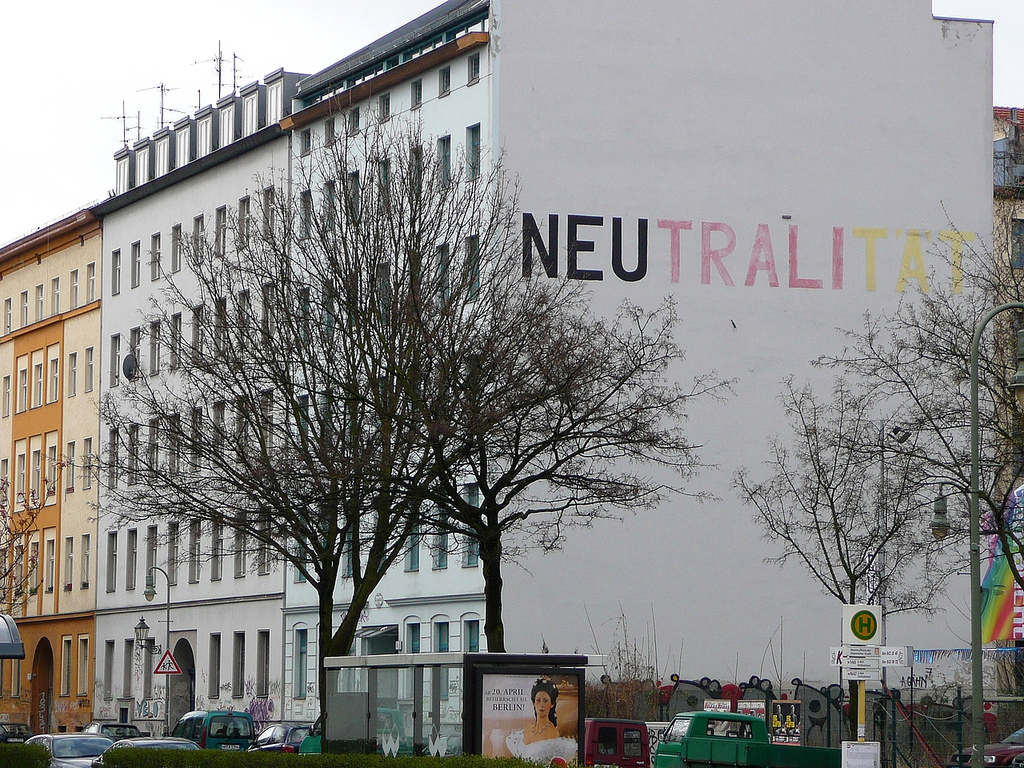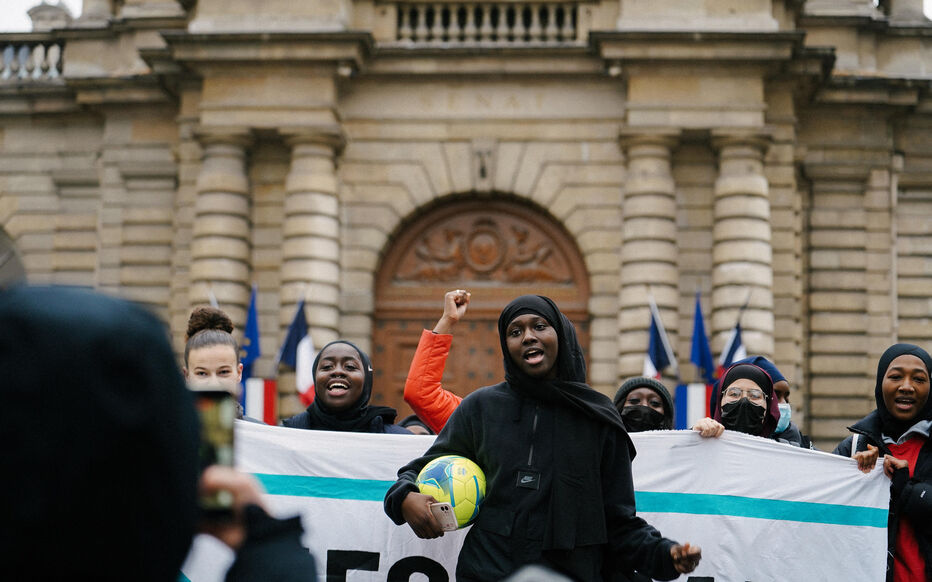In flashy advert campaigns, Berlin, Germany’s capital city, vaunts itself as the world’s “capital of freedom” defined by the coexistence of the widest possible array of diverse lifestyles.1 On a more mundane level, however, successive city administrations have struggled to come to terms with the implications of ethnic and religious diversity.
Berlin’s ‘laic exceptionalism’
Unsurprisingly, in an era of right-wing populism it is the city’s Muslims, their rights, and their individual as well as institutional visibility that have been a particular bone of contention.
The German Constitution is generally open to institutional cooperation between state and religious bodies and the public display of religious affiliations. The strong public role of confessional institutions, as well as the virtually omnipresent feature of religious education (often carried out by clergymen and -women) at public schools are ample testimony to this.
Berlin, however, has taken a different route, steering much closer to a French-style laicité that seeks to banish religion from public institutions. It is in this spirit that the city abolished religious instruction in public schools and in 2005 promulgated a controversial ‘neutrality law’ that forbids exhibiting religious symbols when working in a public function.
A large number of lawsuits
In the past, this has given rise to numerous lawsuits, particularly on the part of Muslim women who wished to become teachers at public schools and were told that they could only exercise their profession if they took off their hijabs. (They are allowed to wear the headcovering in private schools, which are few in number and often of lesser reputation, however.)
Detractors of the ‘neutrality law’ see it as a means to discriminate against Muslim women, who are the most significant target group of these legal provisions. They have also point to the ways in which the law might be seen to clash with the more permissive legal rulings of the German Constitutional Court. Conversely, supporters argue that the law helps to keep the peace in an increasingly diverse city.
In practice, the law has indeed almost exclusively affected Muslim women wearing the hijab; however, in April 2017 a Lutheran teacher was asked to remove her necklace bearing a Christian cross. (The corpus delicti allegedly had a length of 2.8 centimetres.) The incident was harshly criticised as unconstitutional by Lutheran ecclesiastical authorities.2
Green push for repeal of the neutrality law
Now, there are some signs of a political shift in these controversial matters. Berlin’s legislative elections of September 2016 have brought a change of government: while the ruling Social Democrats (SPD) had been in a coalition with the Christian Democrats (CDU) prior to the vote, they have since formed a government together with The Left and Green parties.
It is the Greens in particular – with support from the (socialist-atheist) Left and the Christian Churches – who are demanding a repeal or at least an adjustment of the neutrality law, particularly in the educational domain.3
In a resolution passed at a party conference in early December, the Greens point to the verdict by the Constitutional Court invalidating blanket hijab bans for Muslim schoolteachers. The resolution also calls for a new approach to “visible religion” in the school context, especially given the recent arrival of Arab Muslim refugees.4 Leading Green party politicians are asserting that religious signs and conflicts should not be kept out of schools but that ways must be found to deal with them constructively.5
Social Democrats support the existing law
The Green demands have been taken up by some Social Democratic politicians.6 However, the majority position in the SPD, held also by the CDU, strongly favours the upholding of the neutrality law.
While SPD politician Daniela Kaya claimed that the law amounted to a set of “stigmatisations cast in legal form” that had to be repealed, others demurred. Harald Georgii, SPD chairman in the multi-ethnic (though recently gentrified( Friedrichshain-Kreuzberg district stressed that
We are a free country, as a private person everybody can behave as they like. Whoever wants to do so can also go swimming in a burqa. But if someone takes on an external representative function on behalf of the state, then I expect him to remain neutral in terms of Weltanschauung.7
The SPD’s spokeswoman for integration, Karin Korte, pointed to her own experiences in her home neighbourhood of Neukölln where the majority of students have foreign roots, mostly from Muslim-majority countries. The visible display of religious symbols would only aggravate existing social tensions, in Korte’s view.8
The children’s perspective
It is undoubtedly true that in some of Berlin’s rougher schools religious tolerance can be extremely fragile, as demonstrated by a recent case of anti-Semitic bullying that made national headlines.
At the same time, however, renowned educational NGO Ufuq recently completed a discussion project at a school in central Berlin, gathering 15-year-olds’ opinions on the city’s neutrality law. In the debate, the children bearing German, Turkish, and Arabic names come across as very mature. With near unanimity they assert that religious symbols are irrelevant, as long as the content of the teaching remains unaffected and of high quality.9
Some children drew analogies to tattoos or designer clothing as equally visible outward markers of individual lifestyles and convictions. Others stressed that the display of visible symbols could not be seen as an indication of partiality or prejudice in any straightforward manner, given the fact that many forms of prejudice – such as denigration of the other on the basis of nationality – did not generally manifest themselves visually at all.10
What is a ‘religious symbol’?
Some of the young discussants also highlighted the fact that in the run-up to Christmas, Advent wreaths were placed in some classrooms. They questioned the practice of banning religious symbols such as the hijab or necklaces bearing the Christian cross while sticking with the Advent celebrations.11
This points to an additional difficulty in implementing the neutrality law: there is no exhaustive list of what is to count as a religious symbol. While Berlin’s Department of Education has published a ‘guideline for school administrations’ on how to interpret the requirements of the law, it has also stated that “whoever is waiting for a final list of what is allowed or not will be disappointed.”12
The ‘Islamisation of Berlin’
The populist press was, needlessly to say, much less nuanced in its treatment of the educational, constitutional and philosophical stakes involved in the debate surrounding the neutrality law. The Berliner Kurier newspaper came out with a screaming headline: “The Greens want headscarf-teachers”.13
An AfD politician asserted that “the headscarf is, in the first place, a commitment to political Islam and has no place in schools.”14 The party also issued a tweet showing a woman wearing a niqab, subtitled by the claim that “the Greens are the spearhead of the Islamisation of Berlin”.15
Fears about such ‘Islamisation’ of the German capital received new nourishment from unexpected quarters this week when an Ali Baba-themed childrens’ playground opened in Neukölln. The playground, modelled on Ali Baba’s castle and including a miniature bazaar, a flying carpet, and a treasure chest, was decried by some as a mosque and as a sign of religious indoctrination. The children still seemed to enjoy the opening.16
Sources
https://www.morgenpost.de/berlin/article212737439/Rot-Rot-Gruen-streitet-ueber-Lehrerinnen-mit-Kopftuch.html ↩
http://www.tagesspiegel.de/berlin/neutralitaetsgesetz-in-berlin-gruene-draengen-auf-ende-des-kopftuchverbots/20682922.html ↩
http://www.tagesspiegel.de/berlin/berliner-landesparteitag-gruene-kein-berufsverbot-mehr-fuer-lehrerinnen-mit-kopftuch/20663238.html ↩
https://www.berliner-zeitung.de/berlin/neutralitaetsgesetz-in-die-kopftuch-debatte-kommt-neuer-schwung-29000310 ↩
https://www.morgenpost.de/berlin/article212737439/Rot-Rot-Gruen-streitet-ueber-Lehrerinnen-mit-Kopftuch.html ↩
https://www.morgenpost.de/berlin/article212737439/Rot-Rot-Gruen-streitet-ueber-Lehrerinnen-mit-Kopftuch.html ↩
https://www.berliner-zeitung.de/berlin/neutralitaetsgesetz-in-die-kopftuch-debatte-kommt-neuer-schwung-29000310 ↩
http://www.islamiq.de/2017/05/31/verbotene-symbole-fuer-berliner-lehrer-umstritten/ ↩
https://www.berliner-kurier.de/berlin/kiez—stadt/neutralitaetsgesetz-kritisiert-gruene-wollen-kopftuch-lehrer-28993868 ↩
https://www.morgenpost.de/berlin/article212737439/Rot-Rot-Gruen-streitet-ueber-Lehrerinnen-mit-Kopftuch.html ↩
https://twitter.com/search?q=neutralit%C3%A4tsgesetz&src=typd ↩
http://www.spiegel.de/lebenundlernen/schule/berlin-polizeischutz-fuer-den-ali-baba-spielplatz-a-1182095.html ↩






